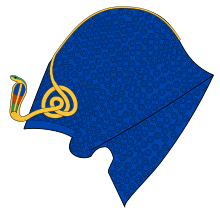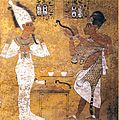Jepresh

La khepresh o jepresh (ḫprš) es un antiguo ornamento real egipcio. También se le denomina corona azul o corona de guerra. Los faraones del Imperio Nuevo fueron a menudo representados con esta corona en la batalla, pero también era usada con frecuencia en ceremonias.[1] Muchos estudiosos solían denominarla corona de guerra, sin embargo los historiadores modernos se abstienen de usar ese nombre.[2]
No ha sido posible hallar un ejemplo original de una khepresh. Basados en las antiguas representaciones artísticas, algunos egiptologos han especulado que la khepresh estaba fabricada de cuero o tela endurecida[3] recubierta de una decoración menuda de cientos de cuentas, discos, o anillos. Dado que la deshret (corona roja) y la hedjet (corona blanca) aparentemente eran tejidas utilizando alguna variedad de fibra vegetal, los círculos o anillos que decoran las representaciones artísticas antiguas de las khepresh es posible que en realidad indiquen un tejido regular de huecos hexagonales en un tejido triaxial abierto. Al igual que en muchas otras coronas reales, un ureo (cobra solar) se adosaba en el frente de la khepresh.
Historia
[editar]| Corona Azul "Corona de Guerra" en jeroglífico |
|
La Corona Azul, o Corona de Guerra, estaba representada en jeroglíficos.
La mención más antigua conocida del khepresh se encuentra en la estela Cairo JE 59635 [CG 20799] que data del reinado del faraón Neferhotep III, durante el Segundo Período Intermedio.[4] En este y otros ejemplos de la misma época, la palabra se escribe con un determinante que representa la corona del capuchón o pañuelo khat, un tipo de corona más baja y menos elaborada. Las imágenes del khepresh del reinado de Amosis I, primer rey del Imperio Nuevo y fundador de la Dinastía XVIII, muestran un tocado que es más alto que la corona del pañuelo khat y más anguloso que las formas posteriores de khepresh. Esta corona continuó evolucionando durante la dinastía XVIII, alcanzando su forma clásica más conocida en los reinados de Hatshepsut y Tutmosis III.[5]
Desde el reinado de Amenofis III, y particularmente durante las dinastías XVIII y XIX, fue ampliamente utilizada e incluso adoptada por algunos faraones como corona principal.[6] La corona dejó de ser representada durante la Dinastía nubia (747 a 656 a. C.).[7]
Durante el Imperio Nuevo, los faraones se mostraron con esta corona en circunstancias militares. Sin embargo, algunos eruditos piensan que la corona también pretendía evocar el poder divino del faraón y, por lo tanto, se usaba para situar religiosamente a los reyes como manifestaciones de los dioses en la tierra.[8]
Galería
[editar]-
Faraón Akenaton
-
Estatuilla de Akenatón y Nefertiti
-
Ushabti de Tutankamón
-
Cabeza de Tutankamón
-
La porta Ay a la derecha, durante la ceremonia de apertura de de la boca sobre la momia de Tutankamón.
-
Esta estatua representa a Amenofis III (retallada después para representar a Ramsés II) portando la corona khepresh. Walters Art Museum, Baltimore.
-
Tutmosis IV con la corona de guerra azul egipcia
Véase también
[editar] Wikimedia Commons alberga una categoría multimedia sobre Jepresh.
Wikimedia Commons alberga una categoría multimedia sobre Jepresh.- Atef – Corona hedjet con plumas que identifica a Osiris
- Deshret – Corona roja del Bajo Egipto
- Hedjet – Corona blanca del Alto Egipto
- Pschent – Corona doble del Bajo y Alto Egipto
- Uraeus – Cobra erguida
Referencias
[editar]- ↑ e.g. Myśliwiec, Karol, Eros on the Nile, Cornell University Press 2004, p.14
- ↑ Kuhrt, Amélie, The Ancient Near East: C.3000–330 B.C., Taylor & Francis 1995, p.190
- ↑ Maisels, Charles Keith, Early Civilizations of the Old World, Routledge 2001, p.60
- ↑ Edwards, Iorwerth Eiddon Stephen; Nicholas Geoffrey Lemprière Hammond, Cyril John Gadd, The Cambridge Ancient History, Cambridge University Press 1975, p.51
- ↑ Davies, W. V., "The Origin of the Blue Crown", The Journal of Egyptian Archaeology, volume 68 (1982), pp. 69–74
- ↑ Bard, Katheryn A., Encyclopedia of the Archaeology of Ancient Egypt, Routledge 1999, p.412
- ↑ Shaw, Ian, The Oxford History of Ancient Egypt, Oxford University Press 2003, p.348
- ↑ Bryan, Betsy. "A 'New' Statue of Amenhotep III and the Meaning of the Khepresh Crown". The Archaeology and Art of Ancient Egypt: Studies in Honor of David O'Connor, ed. Z. Hawass and J. Richards. Cairo, 2007, p. 156-8.
Text is available under the CC BY-SA 4.0 license; additional terms may apply.
Images, videos and audio are available under their respective licenses.








